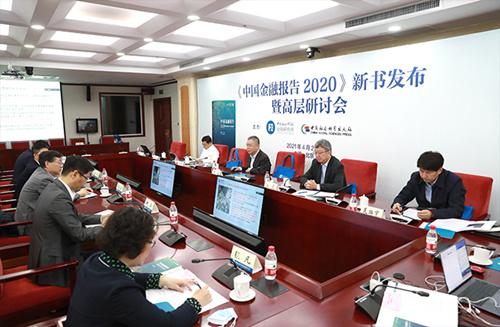
The Chinese Academy of Social Sciences released China Finance Report 2020 at a seminar in Beijing on April 25. Photo: Zhu Gaolei/CSST
The Chinese Academy of Social Sciences (CASS) released China Finance Report 2020 at a seminar in Beijing on April 25.
The Report reviews and summarizes China’s financial development and the risks and challenges it faced in 2020. It contains in-depth discussions on the changing dynamic of financial development in the context of the country’s new development pattern, covering financial security and risk prevention and control, capital market support for the real economy, financial opening and prudential supervision. It also looks ahead to the country’s economic and financial situation in 2021 while offering policy suggestions.
Global financial risks
The current global economic situation is not optimistic. Li Yang, chairman of the National Institution for Finance and Development and a CASS Member, said that data show that by the end of 2020, the total global debt exceeded 281 trillion US dollars, reaching 355% of the world’s GDP. Based on the global population of 7.5 billion, per capita debt is 37,500 US dollars. The full use of currency issuance rights by developed economies has triggered a new wave of debt, the scale of which has never been seen before, and the huge amount of liquidity released by their loose monetary policies has led to the rise in prices of several major assets.
After the pandemic, the global economy will still grow at a low rate, said Wu Zhenyu, director of the Institute of Finance at the Development Research Center of the State Council. Population aging is accelerating, labor supply is slowing, and the burden of population support is increasing across the globe. In addition, the global supply chain and industrial chain are shrinking, and the efficiency of global resource allocation is reduced. Moreover, income inequality is increasing, which affects the growth of demand. Meanwhile, global labor productivity is experiencing sluggish growth.
Zhu Min, director of the National Institute of Finance at Tsinghua University, mentioned that global financial risks exist objectively, which manifest in structural inflation caused by the super-strong stimulus of the US economy and its impact on the global economy. At present, the interactive spillover effect between China’s financial development and world finance is obvious. As such, to a considerable extent, external financial risks have a great impact on China’s internal financial risks.
Financial reform
According to the Report, in the face of the “triple shock” of the spread of the COVID-19 pandemic, the world economy’s severe recession, and continuous and escalating suppression from the United States in 2020, China’s financial system “maintained stability while making progress.” Under the premise of maintaining the bottom line of preventing systemic risks, the country adjusted the orientation of monetary and financial policies in a timely manner, and made efforts on multiple levels such as smoothing economic fluctuations, optimizing the economic structure, and stimulating the vitality of market entities. This has contributed to coordinating pandemic prevention and control, and economic and social development. In addition, the country continued to deepen financial reforms and expand financial opening, while enhancing its financial system’s competitiveness and resilience. Positive progress has been made in the construction of basic capital market systems and the two-way opening of finance.
At present, China’s public sector leverage ratio is about 50% higher than that of the private sector, said Zhang Xiaojing, editor-in-chief for the Report and director of the Institute of Finance and Banking at CASS. China’s local implicit debt’s high interest rate and the rising leverage ratio of the public sector will lead to more public sector debts.
“Our country must further deepen reform of the budget management system, establish a sustainable debt accumulation model, and let the market play a leading role in credit allocation and risk pricing,” Zhang said.
RMB internationalization
Regarding RMB internationalization, Zhou Chengjun, director of the Financial Research Institute at the People’s Bank of China, said that RMB internationalization is a natural process, not seeking to challenge or replace the US dollar, but to share the responsibility of optimizing the international allocation of resources with the US dollar.
In terms of policies, Zhang Liqing, director of the Center for International Finance Studies at Central University of Finance and Economics, suggested ensuring sustained and stable economic growth while further promoting financial reforms and facilitating the national debt market. It is also advisable to achieve a higher-level opening up, and implement two-way opening of financial accounts. China should actively participate in international macro policy coordination, enhance its influence in major international affairs’ decision-making, and actively participate in the construction of global financial security. These policies are of great significance to the future development of RMB internationalization.
Add: #5 Jianguomennei Street, Beijing, 100732,P.R.China
Copyright by CASS. All Rights Reserved

